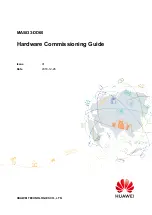
LISA-U1 series - System Integration Manual
3G.G2-HW-10002-3
Preliminary
System description
Page 15 of 125
1.4
Operating modes
LISA-U1 series modules have several operating modes. Table 3 summarizes the various operating modes and
provides general guidelines for operation.
Operating Mode
Description
Features / Remarks
Transition condition
General Status: Power-down
Not-Powered
Mode
VCC
supply not present or
below operating range.
Microprocessor switched off
(not operating).
RTC only operates if supplied
through
V_BCKP
pin.
Module is switched off.
Application interfaces are not
accessible.
Internal RTC timer operates only if a
valid voltage is applied to
V_BCKP
pin.
Module cannot be switched on by a
falling edge provided on the
PWR_ON
input, or by a preset RTC alarm or by a
rising edge provided on the
RESET_N
input.
Module can be switched on applying
VCC
supply.
Power-Off Mode
VCC
supply within operating
range.
Microprocessor switched off
(not operating).
Only RTC runs.
Module is switched off: normal
shutdown after sending the
AT+CPWROFF command (refer to
u-blox AT Commands Manual
Application interfaces are not
accessible.
Only the internal RTC timer in
operation.
Module can be switched on by a falling
edge on the
PWR_ON
input, or by a
rising edge on the
RESET_N
input, or by
a preset RTC alarm.
General Status: Normal Operation
Idle-Mode
Microprocessor runs with
32 kHz as reference oscillator.
Module does not accept data
signals from an external
device.
If power saving is enabled, the module
automatically enters idle mode whenever
possible.
Application interfaces are disabled.
If hardware flow control is enabled, the
CTS
line to ON state indicates that the
module is in active mode and the UART
interface is enabled: the line is driven in
the OFF state when the module is not
prepared to accept data by the UART
interface.
If hardware flow control is disabled, the
CTS
line is fixed to ON state.
Module by default is not set to
automatically enter idle mode whenever
possible, unless power saving
configuration is enabled by appropriate
AT command (refer to
u-blox AT
Commands Manual
[2], AT+UPSV).
Module enters automatically idle mode
when power saving is enabled and there
is no activity for the defined time
interval:
Module registered with the
network and power saving
enabled. Periodically wakes up to
active mode to monitor the paging
channel for the paging block
reception according to network
indication
Module not registered with the
network and power saving is
enabled. Periodically wakes up to
monitor external activity
Module wakes up from idle-mode to
active-mode in the following events:
Incoming voice or data call
RTC alarm occurs
Data received on UART interface
(refer to 1.9.2)
RTS
input line set to the ON state
by the DTE if the AT+UPSV=2
command is sent to the module
(refer to 1.9.2)
USB detection, applying 5 V (typ.)
to the
VUSB_DET
pin
The connected USB host forces a
remote wakeup of the module as
USB device (refer to 1.9.3)
The connected SPI master indicates
to the module that it is ready for
transmission or reception, by the
IPC
SPI_MRDY
signal (refer to
















































